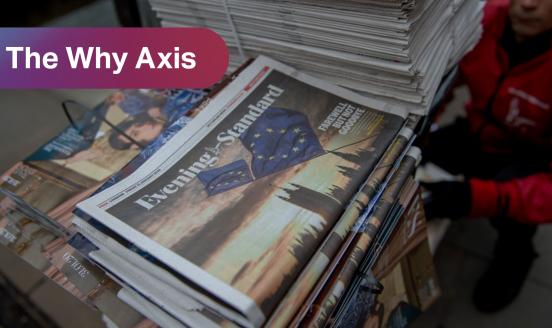The Italian elections
Italy goes to the polls on March 4, with a new electoral law that is largely viewed as unable to deliver a stable government. We review recent opinion

What will happen? According to Italian law, no electoral poll can be published in the two weeks preceding the vote. Luckily for the Italian speaking readers, however, we can still keep up with the latest developments by reading the somewhat cryptic results of “clandestine horse racing” reported here.
Bloomberg Politics instead surveyed economists about their view of most likely scenarios for the Italian elections, and unsurprisingly a lot of them expect a hung parliament (Figure 1 below). They also surveyed economists as to what a variety of scenarios would entail for EU relations, business investment and the Italian recovery (Table below).
Figure 1
Source:Bloomberg
Source:Bloomberg
Valentina Romei in the Financial Times highlights five economic challenges for the incoming Italian government. Italy’s economy is in much better shape than before the last general election in 2013, but the country is still a laggard among its peers and economic discontent has not disappeared. Italy’s growth remains among the slowest in Europe (see Figure below) and it is among few economies OECD countries where output is not yet back to pre-crisis levels.
A related problem is that Italy shows the weakest productivity performance among G7 countries. The country obviously still has very high public debt and bad bank debt, offers poor job opportunities for young people, and despite having improved in terms of ease of doing business it is still lagging behind in terms of foreign direct investments, partly due to political instability.
Source: FT
Public debt is also among the reasons why editors at both Politico and Bloomberg View believe that these elections matter and we should worry about Italy. Bloomberg View’s editors in particular argue that markets are being complacent about the Italian elections, because the vote looks set to produce a coalition government too weak to address the country's twin challenges of slow growth and high debt, and those problems will come to the fore again when the ECB phases out its government-bond purchasing. When the next crisis will hit the euro zone, Italy's broken public finances will be a focus of intense concern.
The Economist discusses the positions of the Northern League, and argues that while there is plenty to fret about in Italy’s election. The parties are making wild promises that, if implemented, would add substantially to Italy’s already vast public debts of more than 130% of GDP. But the idea that the vote could lead to an exit from the euro looks fanciful.
Lucrezia Reichlin writes (in Italian) on Il Corriere della Sera that if we were to unrealistically assume that these elections produce a stable and reformist coalition, then the priority of the latter should be to tackle the number-one problem of the Italian economy – productivity.
Reichlin argues that the government has two ways to act on this – by now very long-lived – Italian problem. First: by investing in the quality of the education system, something that Reichlin thinks is largely absent from electoral programmes. Second: by formulating a comprehensive programme able to foster the adoption of new technologies, based on incentives, regulation and infrastructures. This fictional stable and farsighted government should also think about how to protect the losers from technological progress, a question that will dominate politics in advanced economies over the next decades. What is sure – Reichlin says – is that rejecting progress is not the right answer because it makes everybody poorer.
Carlo Cottarelli – who now works at the Italian Osservatorio Conti Pubblici Italiani (OCPI) of Milan’s Università Cattolica – has asked all the parties running in the elections to submit their economic programmes so as to allow for an assessment of the fiscal measures included in them. Both the programmes and the comments are now out on the OCPI’s website. For the time being, the evaluations of the parties’ fiscal policy programmes are only available in Italian, se we report a short summary in English here below.
The fiscal programme of the centre-right coalition entails expansionary measures for about €136 billion, with coverage for only about €82 billion. Positions, however, differ within the coalition. Forza Italia (FI’s) indicated precise fiscal policy objectives, including the increase of fiscal primary surplus to 4% in 2022, and decline in public debt (by 20 percentage points in five years). OCPI thinks some of the macroeconomic assumptions underlying FI’s programme are optimistic. OCPI argues that with a less optimistic outlook, and without knowing how the new expansionary measures will be covered, public debt would actually reach 135.8% in 2022. The (Northern) League’s programme features a markedly smaller primary balance, which would go to almost zero by 2022, and a significantly slower downward trajectory for debt-to-GDP, which would only decrease by 10 percentage points and the decrease would be due entirely to a projected acceleration of the Italian growth rate.
The fiscal programme of the Democratic Party (PD) entails expansionary measures for a total of €38 billion, mostly due to the introduction of a monthly subsidy for families with dependent children, more measures to fight poverty, infrastructural investment and a cut on corporate taxes. According to OCPI, it is not clear enough how these will be financed. PD has not clearly indicated its public finance objectives for the coming years, but it has announced a plan for public debt reduction, whereby public debt as a ratio of GDP would decrease from 131.6% in 2017 to 118% in 2022 and 100% in 2029. OCPI argues that with less optimistic macroeconomic assumptions and without knowing how the new expansionary measures will be covered, debt-to-GDP would instead reach 134.8% in 2022.
5 Stars Movement (M5S) has not published a fiscal policy programme for the next five years, but only indicated the objective to reduce the debt-to-GDP ratio by 40 percentage points in 10 years. OCPI points out that such a rapid trajectory of debt reduction would require a very rapid achievement of a balanced budget (or a surplus), unless we hypothesise real GDP growth to be around 5-6%, which is unrealistic for the Italian economy. Absent of any clarification on how new expansionary measures will be financed, the measures included in the M5S’ programme would lead to a primary balance deficit of about €64 billion (3.2% in 2022) and even assuming a favourable macroeconomic environment, the debt-to-GDP ratio would reach 138.4% in 2022. The 5 Stars Movement has published a response to Cottarelli on their website, explaining their underlying growth assumptions and disputing part of OCPI’s assessment.
Cottarelli is not the only one to keep a close eye on parties’ economic programmes. The Italian economist Roberto Perotti has published his own assessments on the Italian newspaper La Repubblica. By looking into the details of the parties’ programmes, he has put together an estimate of costs and funding of parties’ promises for M5S, PD and the centre-right coalition. The numbers differ from Cottarelli’s, but the main message remains that there is a general lack of clarity about how new measures will be financed.



